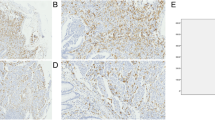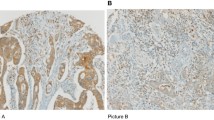Abstract
Background
Prediction of poor patient outcome as a effect of adjuvant therapy in stage II colorectal cancer (CRC) remains a matter of controversy. Tumor expression of CD10 and CD15 is reportedly related to poor outcome in CRC. In this study, we investigated whether the expression of CD10 and CD15 is a predictor of outcome and the effect of adjuvant therapy in stage II CRC.
Materials and methods
Immunohistochemical analyses for CD10 and CD15 and some additional markers (CD11b, CD14, CD163, CD3, and CD20) were performed using paraffin sections of CRC specimens from 57 patients who had undergone curative surgical treatments between 1998 and 2004. Forty of these patients received postoperative adjuvant therapy. We distinguished between expression in tumor cells (tCD10 and tCD15), in stromal cells (sCD10), and infiltrating immune cells (iCD10 and iCD15).
Results
Expression of iCD10 was observed in 21.1% (12/57) of the specimens examined. Of all expression patterns, only iCD10 expression at the cancer invasion front was a useful predictor of a disease-free period and overall survival in stage II CRC. Adjuvant therapy improved the outcome of iCD10+ patients. CD10+ immune cells were heterogeneous in origin and partially overlapped the cells positive for myeloid lineage markers, including CD11b and CD15.
Conclusions
iCD10 expression at the tumor invasion front is a useful marker for predicting a high risk of recurrence and mortality in stage II CRCs. CD10+ immune cells appear to be of myeloid origin.





Similar content being viewed by others
References
Jemal A, Siegel R, Ward E et al (2008) Cancer statistics, 2008. CA Cancer J Clin 58(2):71–96
Greene FL, Stewart AK, Norton HJ (2002) A new TNM staging strategy for node-positive (stage III) colon cancer: an analysis of 50,042 patients. Ann Surg 236(4):416–421
Lin CC, Lin JK, Chang SC et al (2009) Is adjuvant chemotherapy beneficial to high risk stage II colon cancer? Analysis in a single institute. Int J Colorectal Dis 24(6):665–676
Köhne CH (2006) Should adjuvant chemotherapy become standard treatment for patients with stage II colon cancer? Against the proposal. Lancet Oncol 7(6):516–517
Sobrero A (2006) Should adjuvant chemotherapy become standard treatment for patients with stage II colon cancer? For the proposal. Lancet Oncol 7(6):515–516
Greaves MF, Hariri G, Newman RA et al (1983) Selective expression of the common acute lymphoblastic leukemia (gp 100) antigen on immature lymphoid cells and their malignant counterparts. Blood 61:628–639
McIntosh GG, Lodge AJ, Watson P et al (1999) NCL-CD10–270: a new monoclonal antibody recognizing CD10 in paraffin-embedded tissue. Am J Pathol 154(1):77–82
Yasuda M, Itoh J, Satoh Y et al (2005) Availability of CD10 as a histopathological diagnostic marker. Acta Histochem Cytochem 38(1):17–24
Fujimoto Y, Nakanishi Y, Sekine S et al (2005) CD10 expression in colorectal carcinoma correlates with liver metastasis. Dis Colon Rectum 48(10):1883–1889
Yao T, Tsutsumi S, Akaiwa Y et al (2001) Phenotypic expression of colorectal adenocarcinomas with reference to tumor development and biological behavior. Jpn J Cancer Res 92:755–761
Huang WB, Zhou XJ, Chen JY et al (2005) CD10-positive stromal cells in gastric carcinoma: correlation with invasion and metastasis. Jpn J Clin Oncol 35(5):245–250
Ogawa H, Iwaya K, Izumi M et al (2002) Expression of CD10 by stromal cells during colorectal tumor development. Hum Pathol 33(8):806–811
Nakamori S, Kameyama M, Imaoka S et al (1993) Increased expression of sialyl Lewisx antigen correlates with poor survival in patients with colorectal carcinoma: clinicopathological and immunohistochemical study. Cancer Res 53(15):3632–3637
Nakamori S, Kameyama M, Imaoka S et al (1997) Involvement of carbohydrate antigen sialyl Lewis(x) in colorectal cancer metastasis. Dis Colon Rectum 40(4):420–431
Ohji Y, Yao T, Eguchi T et al (2007) Evaluation of risk of liver metastasis in colorectal adenocarcinoma based on the combination of risk factors including CD10 expression: multivariate analysis of clinicopathological and immunohistochemical factors. Oncol Rep 17(3):525–530
Sato Y, Itoh F, Hinoda Y et al (1996) Expression of CD10/neutral endopeptidase in normal and malignant tissues of the human stomach and colon. J Gastroenterol 31(1):12–17
Connelly JC, Chambless R, Holiday D et al (1993) Up-regulation of neutral endopeptidase (CALLA) in human neutrophils by granulocyte-macrophage colony-stimulating factor. J Leukoc Biol 53(6):685–690
Coussens LM, Werb Z (2002) Inflammation and cancer. Nature 420(6917):860–867
Lin EY, Pollard JW (2004) Role of infiltrated leucocytes in tumor growth and spread. Br J Cancer 90(11):2053–2058
Arias JI, Aller MA, Arias J (2007) Cancer cell: using inflammation to invade the host. Mol Cancer 6:29
Mantovani A, Allavena P, Sica A et al (2008) Cancer-related inflammation. Nature 454(7203):436–444
Fernandez-Acenero MJ, Galindo-Gallego M, Sanz J et al (2000) Prognostic influence of tumor-associated eosinophilic infiltrate in colorectal carcinoma. Cancer 88(7):1544–1548
Klintrup K, Mäkinen JM, Kauppila S et al (2005) Inflammation and prognosis in colorectal cancer. Eur J Cancer 41(17):2645–2654
Serafini P, Borrello I, Bronte V (2006) Myeloid suppressor cells in cancer: recruitment, phenotype, properties, and mechanisms of immune suppression. Semin Cancer Biol 16(1):53–65
Ostrand-Rosenberg S, Sinha P (2009) Myeloid-derived suppressor cells: linking inflammation and cancer. J Immunol 182(8):4499–4506
Gabrilovich DI, Nagaraj S (2009) Myeloid-derived suppressor cells as regulators of the immune system. Nat Rev Immunol 9(3):162–174
Shojaei F, Zhong C, Wu X et al (2008) Role of myeloid cells in tumor angiogenesis and growth. Trends Cell Biol 18(8):372–378
Murdoch C, Muthana M, Coffelt SB et al (2008) The role of myeloid cells in the promotion of tumour angiogenesis. Nat Rev Cancer 8(8):618–631
Zumsteg A, Baeriswyl V, Imaizumi N et al (2009) Myeloid cells contribute to tumor lymphangiogenesis. PLoS One 4(9):e7067
Hall PA, D’Ardenne AJ (1987) Value of CD15 immunostaining in diagnosing Hodgkin’s disease: a review of the published literature. J Clin Pathol 40:1298–1304
Fujita S, Taniguchi H, Yao T et al (2010) Multi-institutional study of risk factors of liver metastasis from colorectal cancer: correlation with CD10 expression. Int J Colorectal Dis 25(6):681–686
Braun MP, Martin PJ, Ledbetter JA et al (1983) Granulocytes and cultured human fibroblasts express common acute lymphoblastic leukemia-associated antigens. Blood 61(4):718–725
Demirci U, Coskun U, Sancak B et al (2009) Serum granulocyte macrophage-colony stimulating factor: a tumor marker in colorectal carcinoma? Asian Pac J Cancer Prev 10(6):1021–1024
Conflict of interest
No author has any conflict of interest.
Author information
Authors and Affiliations
Corresponding author
Electronic supplementary material
Below is the link to the electronic supplementary material.
About this article
Cite this article
Khanh, D.T., Mekata, E., Mukaisho, Ki. et al. Myeloid cells positive for CD10 at invasion front can predict poor outcome in stage II colorectal cancer. Int J Clin Oncol 17, 240–249 (2012). https://doi.org/10.1007/s10147-011-0281-8
Received:
Accepted:
Published:
Issue Date:
DOI: https://doi.org/10.1007/s10147-011-0281-8




